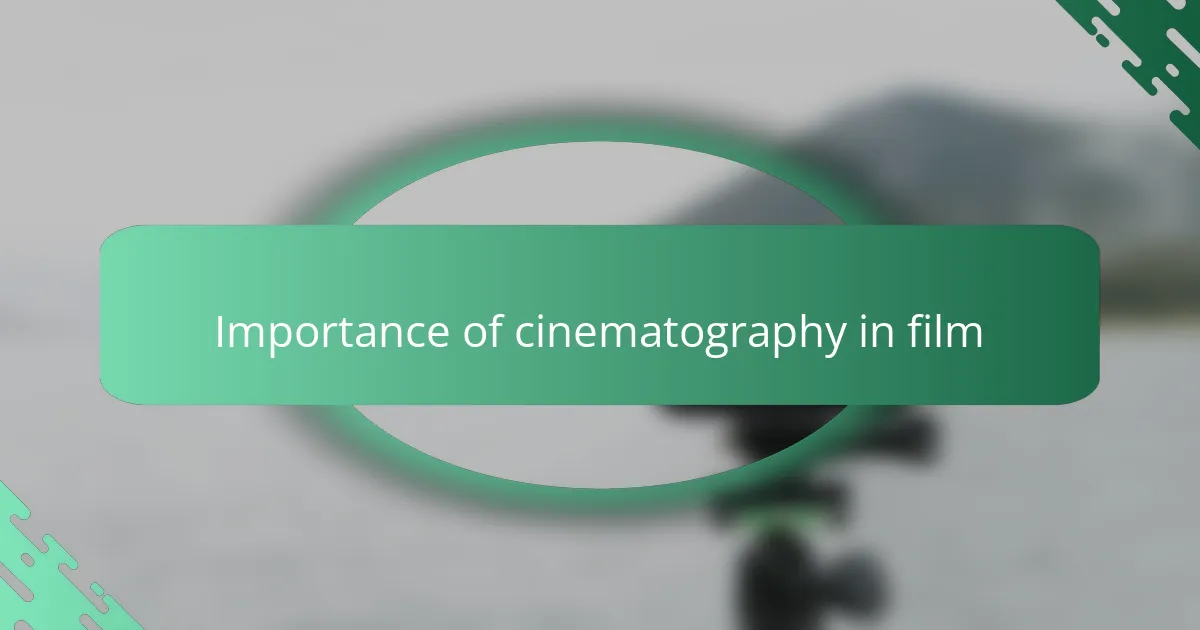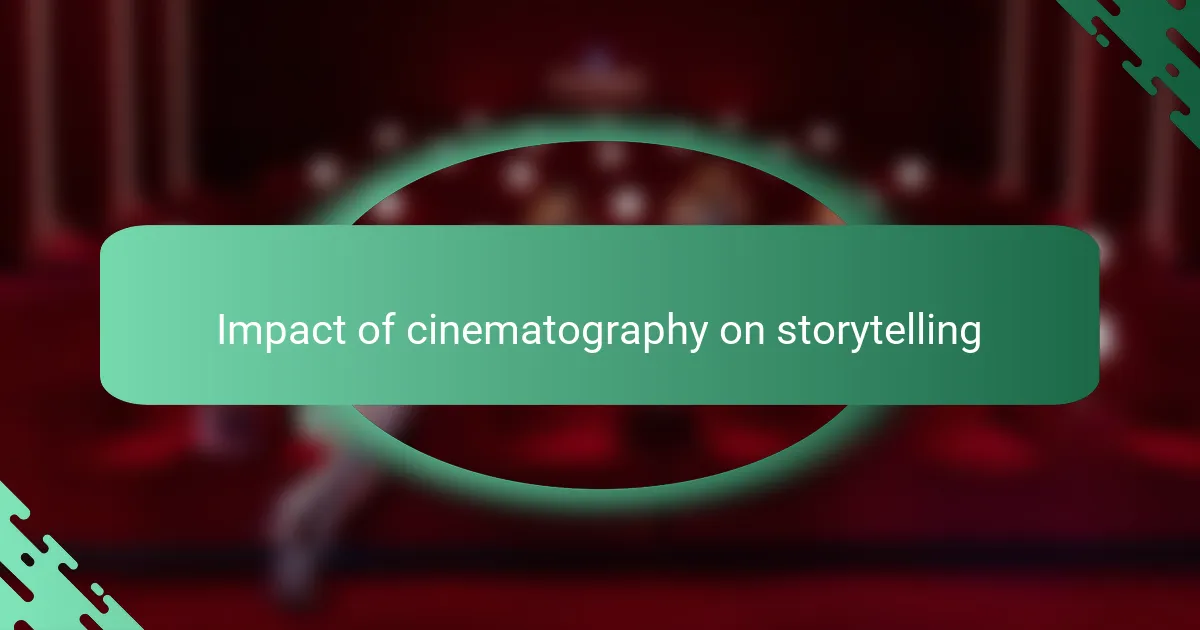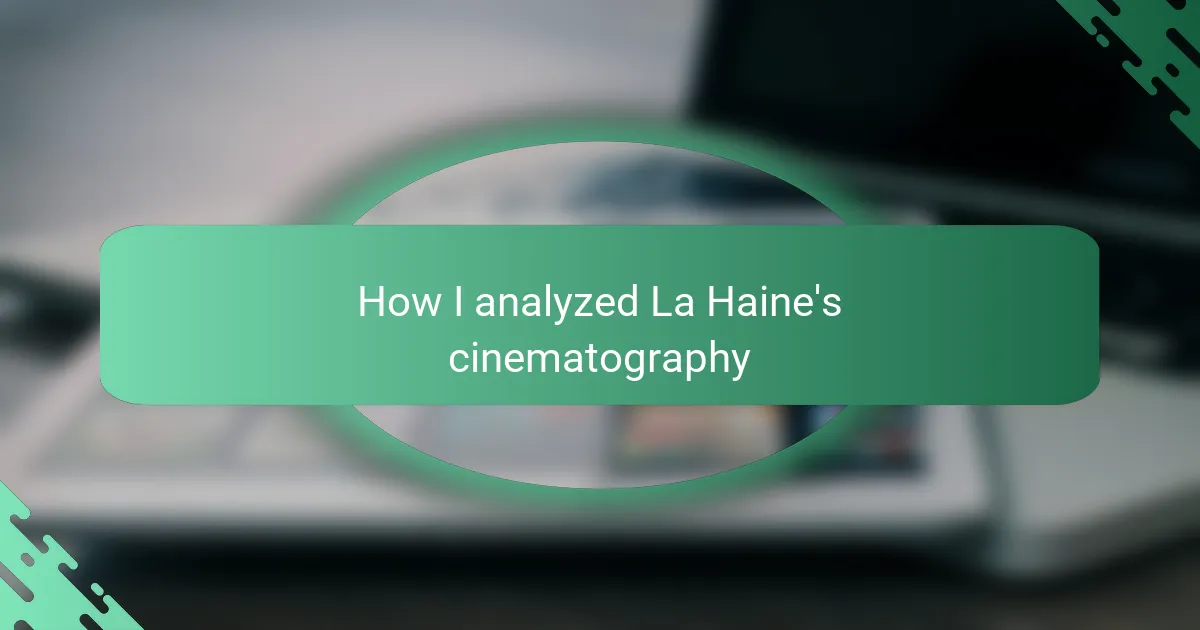Key takeaways
- The black and white cinematography of “La Haine” effectively reflects the bleak social realities and emotional intensity of the characters.
- Dynamic camera movements and close-ups create an immersive experience, drawing viewers into the protagonists’ chaotic lives.
- Lighting choices enhance emotional depth, emphasizing themes of despair and urgency throughout the film.
- Cinematographic elements like framing and camera angles help convey character relationships and societal issues, enriching the storytelling.

Overview of La Haine cinematography
The cinematography of “La Haine” is striking and purposeful, employing black and white imagery that reflects the stark social realities faced by the characters. I remember watching it for the first time, feeling the weight of the visual choices—it almost felt like stepping into a gritty documentary. The use of dynamic camera movements and creative framing enhances the film’s intense atmosphere, drawing viewers deeply into the lives and struggles of the protagonists.
One can’t overlook how the close-up shots convey raw emotions effectively, making the audience feel an intimate connection to the characters’ experiences. The film’s cinematographer, Pierre Aïm, did a remarkable job using light and shadow to emphasize not just the environment but the palpable tension in the storyline. Each visual element serves a purpose, and I found myself captivated by how well it mirrors the themes of anger, despair, and hope.
| Aspect | Description |
|---|---|
| Format | Black and White |
| Camera Movements | Dynamic and Fluid |
| Framing | Intimate Close-ups |
| Lighting | High Contrast |

Importance of cinematography in film
Cinematography is truly the backbone of film, as it shapes the audience’s experience and emotional response. When watching “La Haine,” I found myself drawn into its raw energy and gritty realism largely due to the distinct visual style. The choice of black and white, for instance, enhances the film’s stark themes, transporting you to the heart of the social issues portrayed.
When analyzing cinematography, it’s essential to consider how it influences storytelling. Here are some key aspects to keep in mind:
- Visual Tone: The color palette sets the mood—”La Haine” uses monochrome to emphasize despair.
- Camera Angles: Unique perspectives can create tension or empathy, as seen in the close-ups of the characters’ expressions.
- Lighting: Strategic lighting highlights emotions, adding depth to scenes and inviting viewers to feel along with the characters.
- Movement: Camera movement can convey urgency or tranquility, guiding the viewer’s emotional journey throughout the film.
- Framing: How shots are composed can lead to a deeper understanding of the characters’ relationships and societal context.
Reflecting on my own viewing experience, I found that these elements not only support the narrative but also provoke thought about broader themes, making cinematography an indispensable aspect of film.

Key elements of cinematography
When I think about the key elements of cinematography in “La Haine,” the first aspect that springs to mind is the use of lighting. The high contrast between light and shadow not only enhances the stark black and white visuals but also creates a visceral atmosphere. I recall a moment where the harsh lighting illuminated the characters’ faces just right, allowing me to feel their anguish and frustration. It’s fascinating how these lighting choices can evoke such strong emotions, drawing us into their world.
Another critical component is the dynamic camera movements. The fluidity of the shots keeps the audience engaged and amplifies the tension throughout the film. I remember feeling almost breathless during the fast-paced sequences as the camera whirled around the characters, mirroring their chaotic lives. Have you ever felt that rush during a film? It’s like the camera becomes an extension of the characters’ own perspectives, pulling you deeper into their struggles.
Framing also plays a significant role in conveying the film’s themes. The close-ups specifically create an intimate connection with the characters, allowing us to share in their experiences. I found that these shots often held more weight than lengthy dialogue. When I saw the pain in their eyes, it struck a chord within me. It’s a reminder of how powerful visual storytelling can be, isn’t it? Each choice made by the cinematographer resonates beyond the frame, shaping our understanding of the narrative.

Analysis techniques for film reviews
Analyzing film reviews can be a subjective journey, but employing specific techniques makes the process more engaging. Personally, I often focus on visual storytelling elements, examining how cinematography influences not only the narrative but the emotional weight of scenes. By dissecting scenes shot by shot, I can reflect on how the camera’s movement and framing choices capture the essence of the characters’ struggles, much like the close-ups in “La Haine” that resonate deeply with me.
I find it helpful to take notes during viewings, especially on how lighting choices affect the mood. For example, in “La Haine,” the high-contrast lighting does more than just illuminate; it intensifies the tension and sets a bleak tone that stays with you long after the film ends. Isn’t it fascinating how these visual elements can speak volumes without a single word? When I look back at those intense moments, I realize that I was feeling the characters’ pain right alongside them, thanks to the cinematographer’s skillful use of light and shadow.
Another technique I employ is to compare different scenes and analyze how varied camera angles contribute to the overall emotional arc. In “La Haine,” the dynamic camera movements mirror the protagonists’ chaotic lives, creating a visceral connection for viewers. Have you ever been swept up in such a whirlwind? It’s the cinematography that carries us along, pushing us to understand the urgency of their experiences. By recognizing these key techniques, one can appreciate film on a deeper level, transforming mere viewing into an insightful dialogue about the art of cinema.

Personal insights from La Haine
The cinematography in “La Haine” deeply resonated with me, especially in how it captures the raw emotions of its characters. I vividly remember the first time I watched the film; the stark contrast between the gritty urban landscape and the intimate close-ups on characters’ faces left a lasting impression. The use of black and white not only enhances the bleak atmosphere but also amplifies the urgency and tension of the narrative, making it feel almost like a documentary.
Reflecting on specific moments, the way the camera follows the characters creates an immersive experience. It feels as if you’re right there in the chaos of the banlieue, sharing in their frustrations and despair. This direct engagement reminded me of the times I’ve felt disconnected from my surroundings, igniting a powerful emotional response that lingers long after the credits roll.
- The choice of black and white cinematography evokes a sense of timelessness and urgency.
- Dynamic tracking shots draw viewers into the characters’ chaotic world.
- Close-ups effectively highlight emotional turmoil and interpersonal tension.
- The stark urban settings serve as a silent character in the story, reflecting societal issues.
- The film’s visual style mirrors the themes of alienation and violence, leaving a profound impact on the audience.

Impact of cinematography on storytelling
Cinematography plays a pivotal role in storytelling, particularly in films like La Haine. The choice of lighting, camera angles, and shot composition doesn’t just illustrate the narrative; it immerses the viewer in the characters’ emotional states. For instance, the stark black-and-white visuals highlight the rawness of the characters’ struggles, making their experiences feel immediate and personal.
When I first watched La Haine, the intense close-ups let me connect deeply with the characters’ frustrations. Each frame felt like a window into their souls, reflecting the impact of societal issues. It’s amazing how the visual elements can evoke such strong feelings and compel the audience to engage actively with the story.
Here’s a simple comparison of cinematographic elements that enhance storytelling:
| Cinematography Element | Impact on Storytelling |
|---|---|
| Lighting | Sets the mood, emphasizes emotional states |
| Camera Angles | Influences perspective, creates tension or empathy |
| Shot Composition | Directs focus, enhances narrative themes |
